[MM] Florence-2: Advancing a Unified Representation for a Variety of Vision Tasks
[MM] Florence-2: Advancing a Unified Representation for a Variety of Vision Tasks
- paper: https://arxiv.org/pdf/2311.06242
- github: https://huggingface.co/microsoft/Florence-2-base
- archived (인용수: 10회, ‘24-07-10 기준)
- downstream task: zero-shot object detection & captioning & segmentation
1. Motivation
-
Multi-task 수행할 수 있는 Vision Foundation Model을 만들기 위해서는 공간적 / 의미론으로 다양한 spectrum의 complex task를 통해 학습해야 한다.
-
하지만, 이를 학습하기 위해서는 포괄적인 visual annotation을 필요로 한다.
$\to$ 포괄적인 visual feature를 unified pretraining framework를 통해 singular network로 학습해보면 어떨까?

2. Contribution
- 다재다능한 visual foundation model Florence-2를 제안한
- Vision-Language tasks: Zero-shot captioning & visual grounding & referring expression comprehension
- Vision tasks: Zero-shot classification & object detection & semantic segmentation
- Finetuning 이후에는 SOTA specialist 성능을 냄
- Florence의 backbone은 다른 SSL 기반 backbone보다 downstream task에서 좋은 성능을 냄 $\to$ visual representation을 잘 학습
3. Florence-2
3.1 Rethinking Vision Model Pre-training
-
Self-supervised Learning / Weakly-supervised Learning / Supervised Learning의 한계
-
SSL: 좋은 feature를 학습하지만, 특정 attribute를 증폭함
-
WSL: 구조화되지 않은 textual annotation을 활용하는 장점이 있지만, image-level feature만 학습함
-
SL: Object recognition은 잘하지만, adaptability가 약함
$\to$ Unified VFM 학습하기 위해서는 single task limitation을 해결하고, visual & textual semantics를 통합해 학습해야함
-
3.2 Comprehensive Multitask Learning
위의 제약을 해결하기 위해 다양한 multi task learning을 수행함
-
Image-level Understanding
-
high-level semantic을 학습하기 위해 linguistic description을 통해 학습함
ex. Image captioning, Image classificaiton, Visual Question & Answering
-
-
Region/pixel-level Understanding
-
구체적인 object & entity localization, object간의 관계 (공간적인)을 학습
ex. Object detection, Semantic segmentation, Referring expression comprehension
-
-
Fine-grained visual-semantic alignment
-
Local detail을 capture하기 위해 local visual entities, semantic concept을 이해하도록 학습
ex. fine-grained text & visual understanding
-
3.3 Model
-
overall architecture : seq2seq paradigm
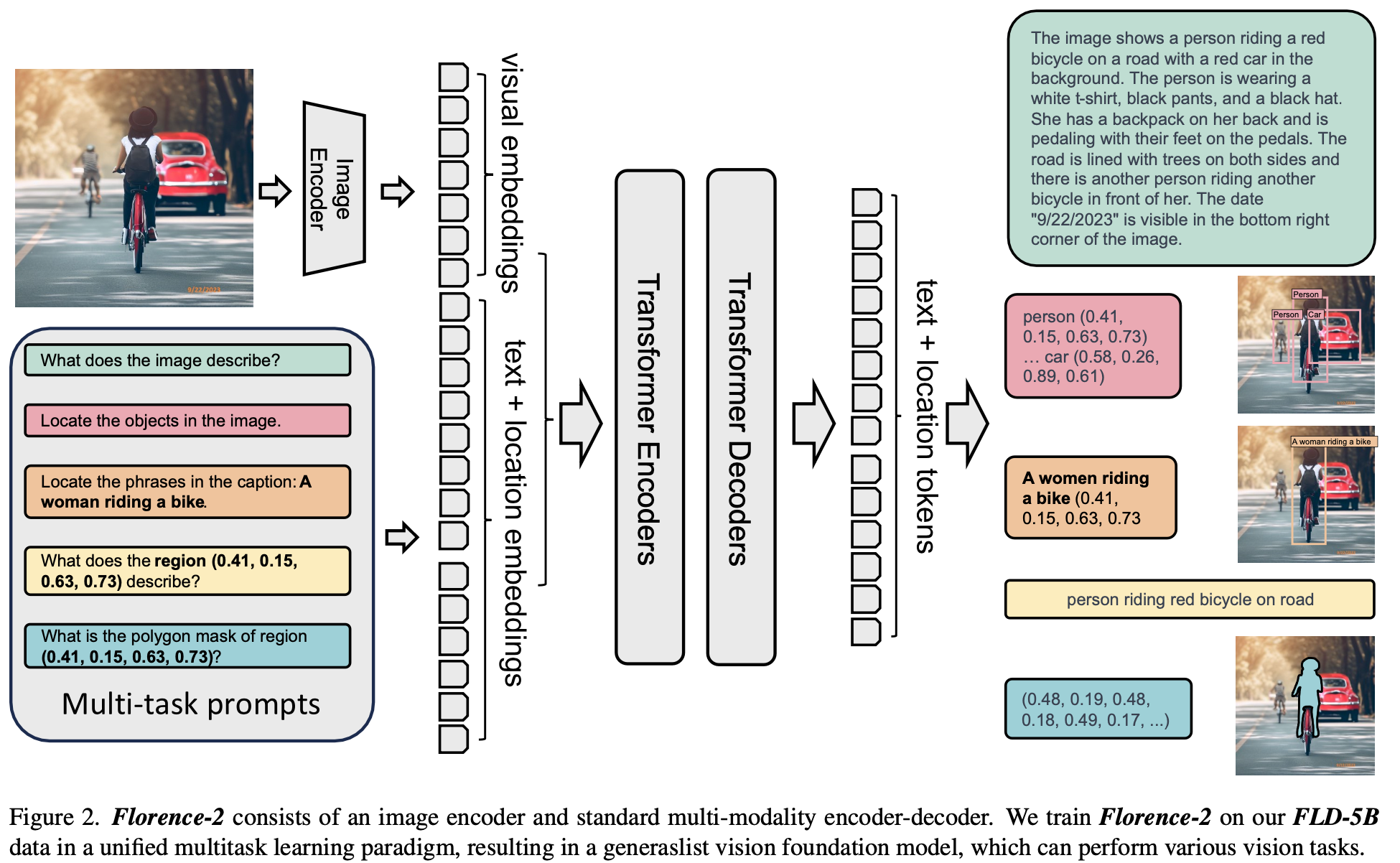
-
Input: Text-specific prompt와 image를 입력
-
모든 task를 translation problem으로 정의
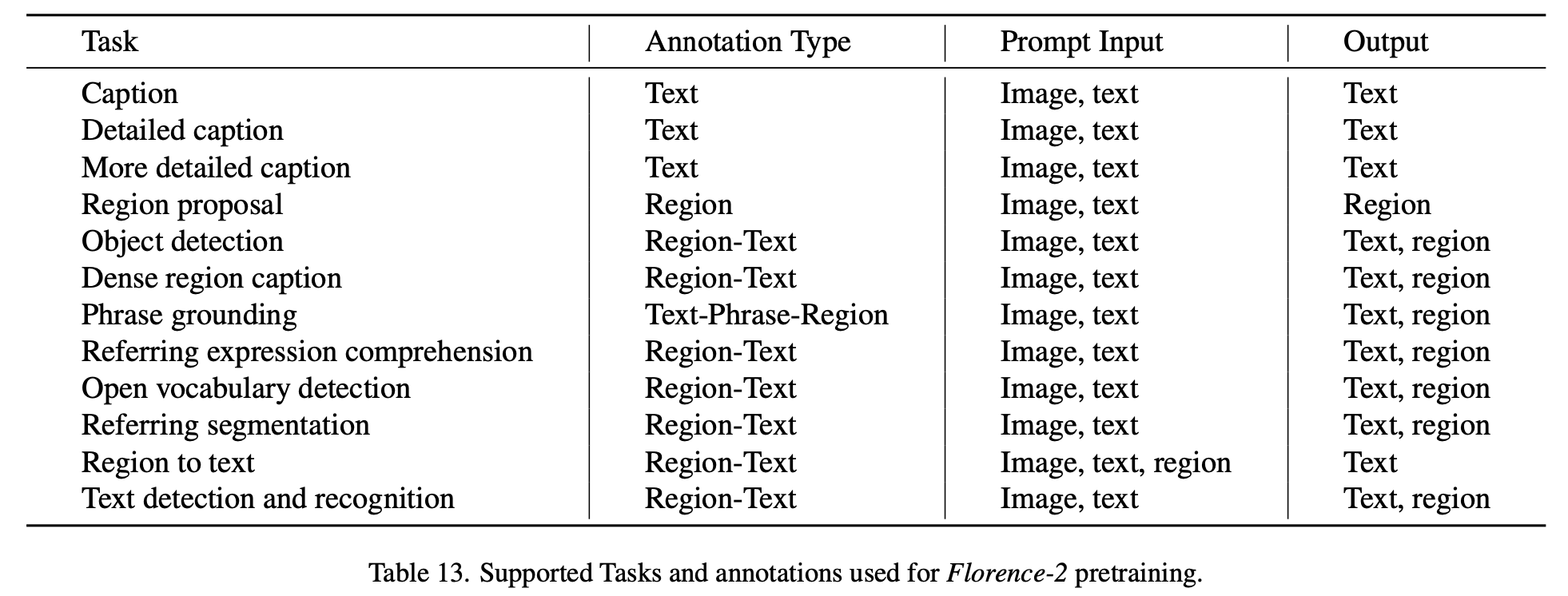
-
-
Output: text / region
- region: 해당 localized 영역을 좌표로 표시 $\to$ 1,000개의 localized bin을 additional vocabulary로 학습
-
Architecture
- Visual Encoder: DaViT
- Multimodality encoder-decoder
- input
- text embedding: T$_{prompt} \in \mathbb{R}^{N_t \times D}$
- visual embedding: V $ \in \mathbb{R}^{N_v \times D}$
- input
-
Objectives

-
3.3 Data Engine
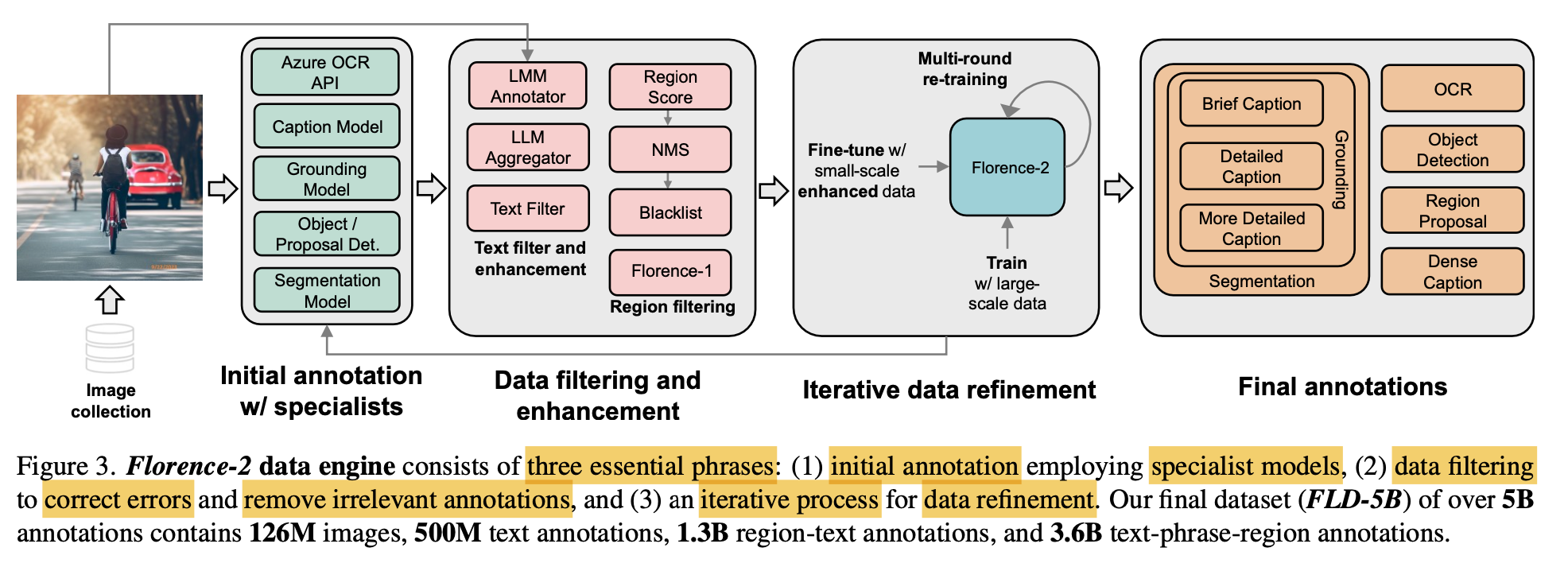
(1) initial annotation: Opensource Benchmark의 human annotation을 적극 활용하되, specialized model의 synthetic annotation도 사용
(2) Data filtering & enhancement: 너무 복잡한 object를 갖는 이미지는 filtering (대체로 noisy하므로) + bbox 가 confidence score 낮으면 filtering
(3) Iterative data refinement: filtered data로 학습한 모델의 출력을 가지고 annotation을 수정해서 재학습
-
FLD-5B
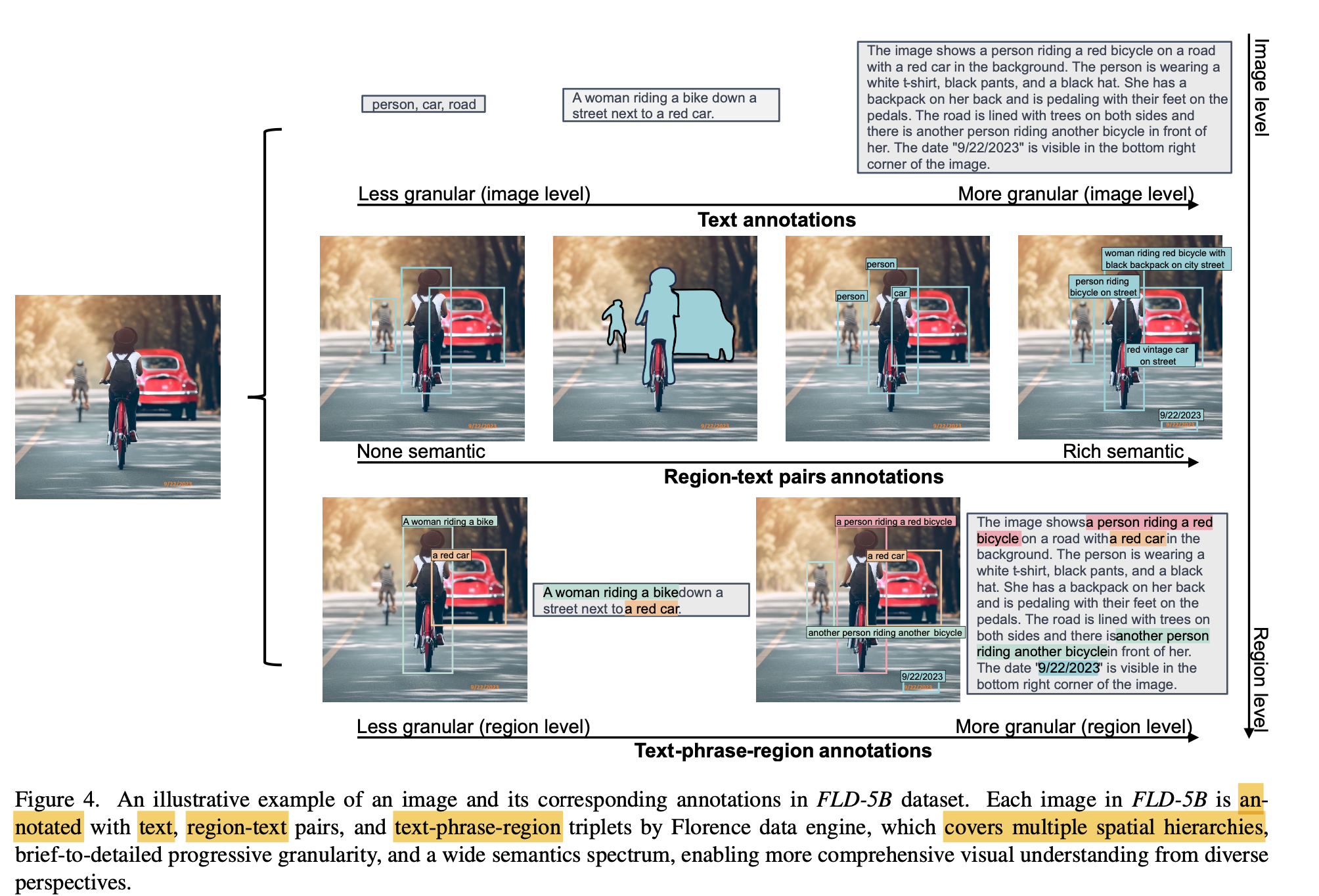
-
Images: 126M
-
Text annotation: 500M
-
text-region: 1.3B
-
text phrase-region: 3.6B
3.4 Data Analysis
-
Annotation Statistics

-
Semantic Coverage: SpaCy에 영감을 얻어 POS(part-of-speech) tags & dependency parsing tree로 측정 $\to$ [18] 참고
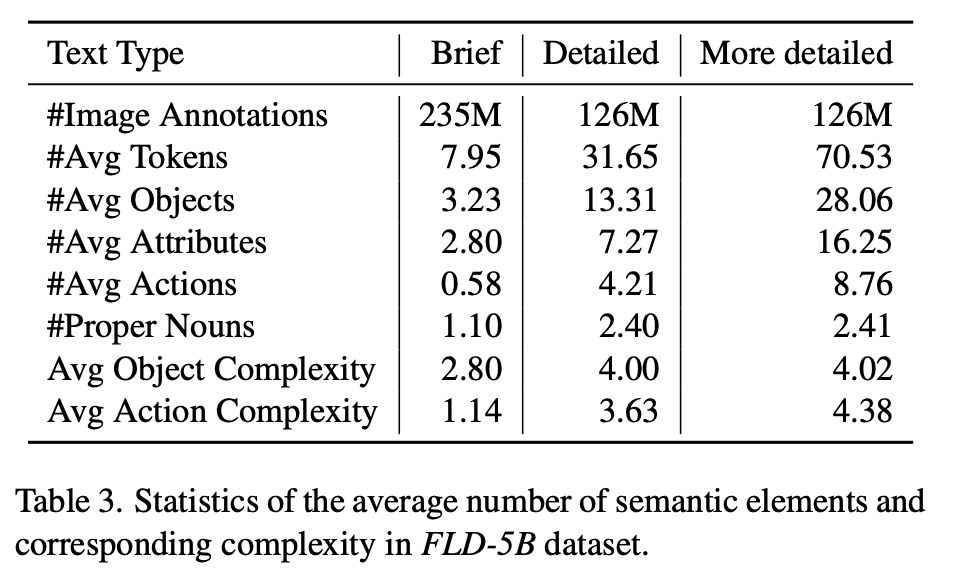
-
BBox의 분포

-
4. Experiments
-
Zero-shot Vision-Lanugage tasks
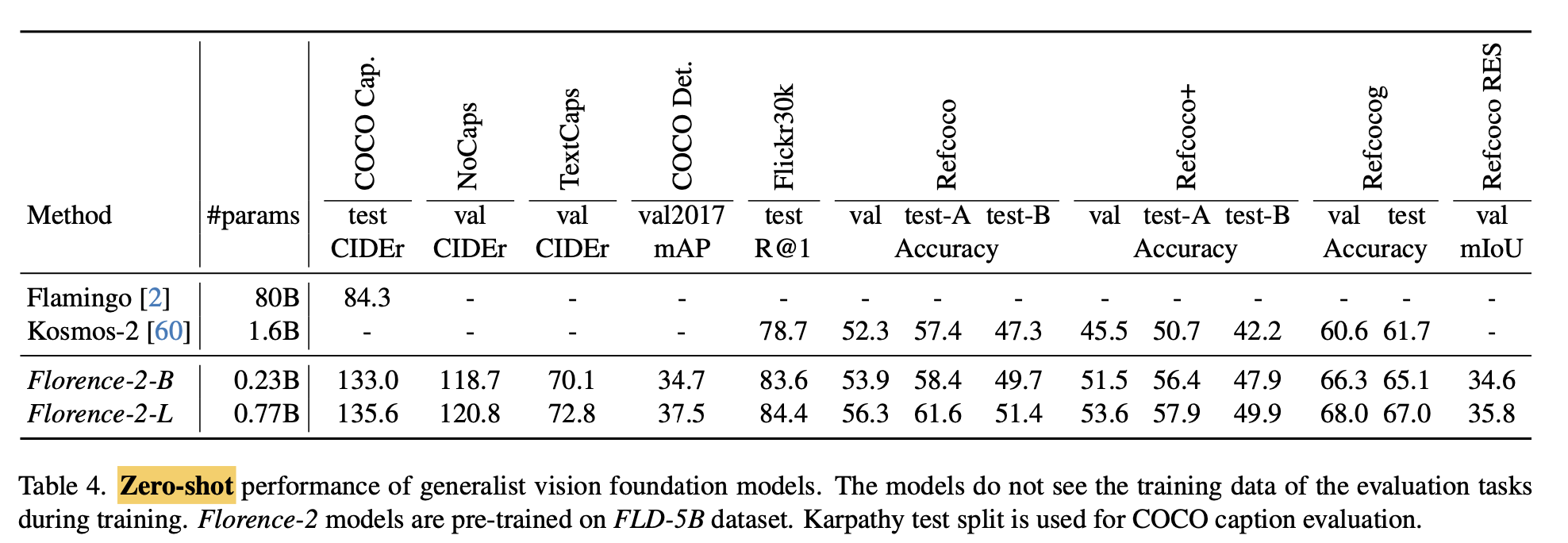
-
Specialist performance: 해당 dataset으로 finetuned 결과
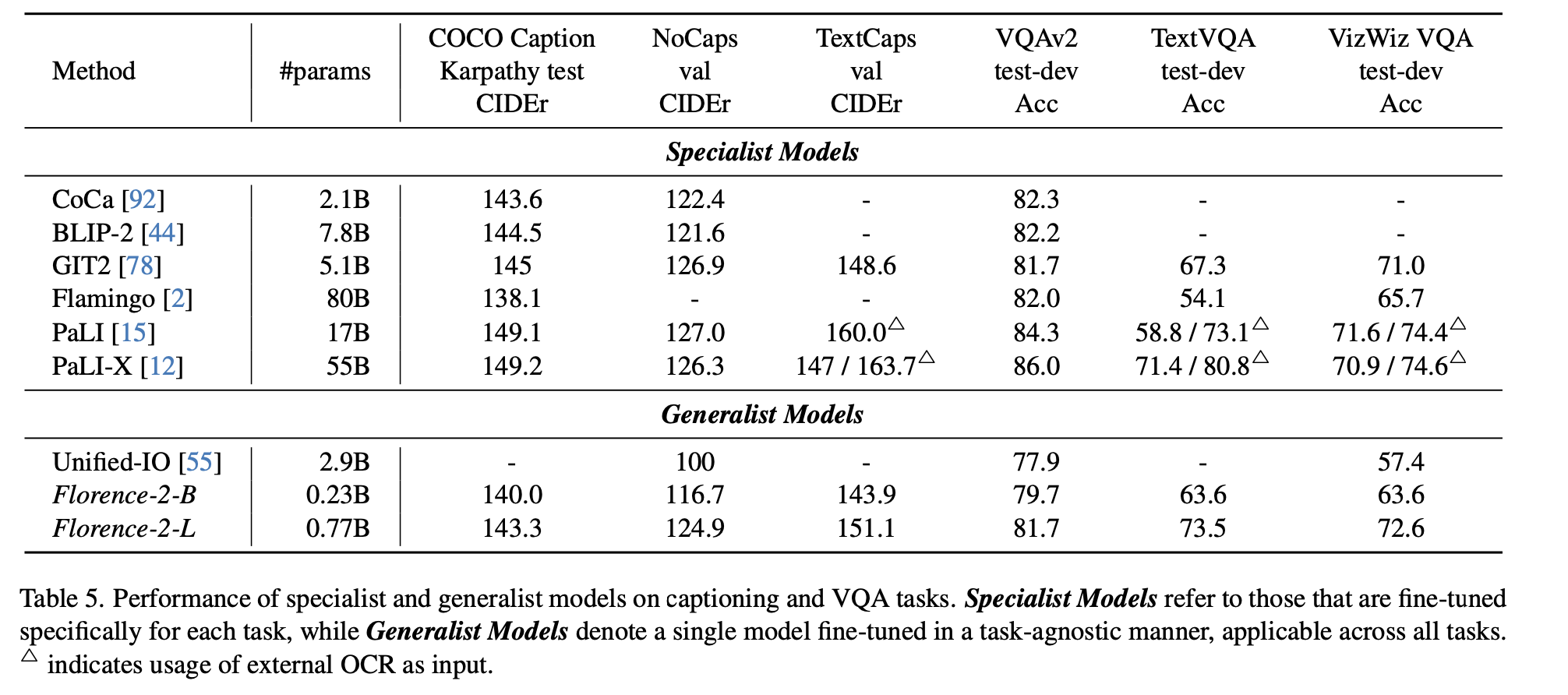
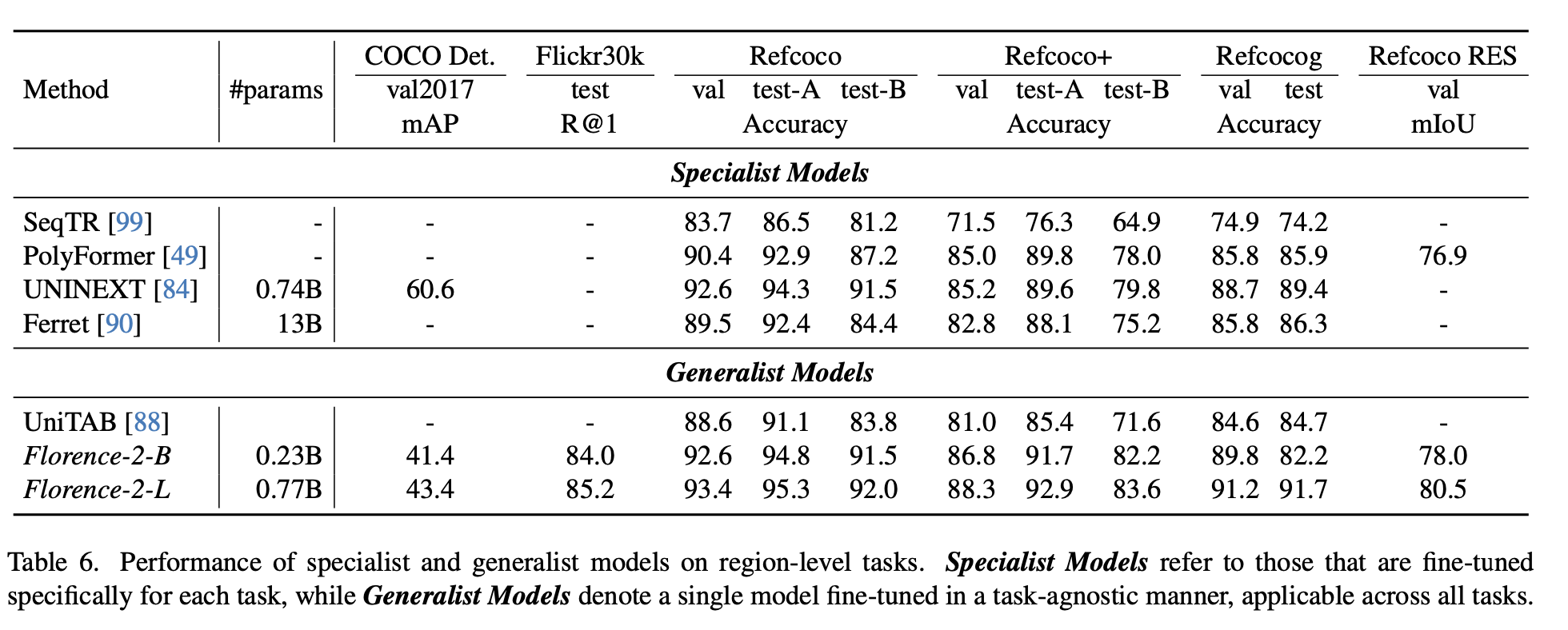
-
Training Efficay 분석

Florence가 supervised pretraining보다 downstream task에 성능 향상을 시킨다 $\to$ 좋은 visual representation이라는 반증
-
object detection

-
semantic segmentation
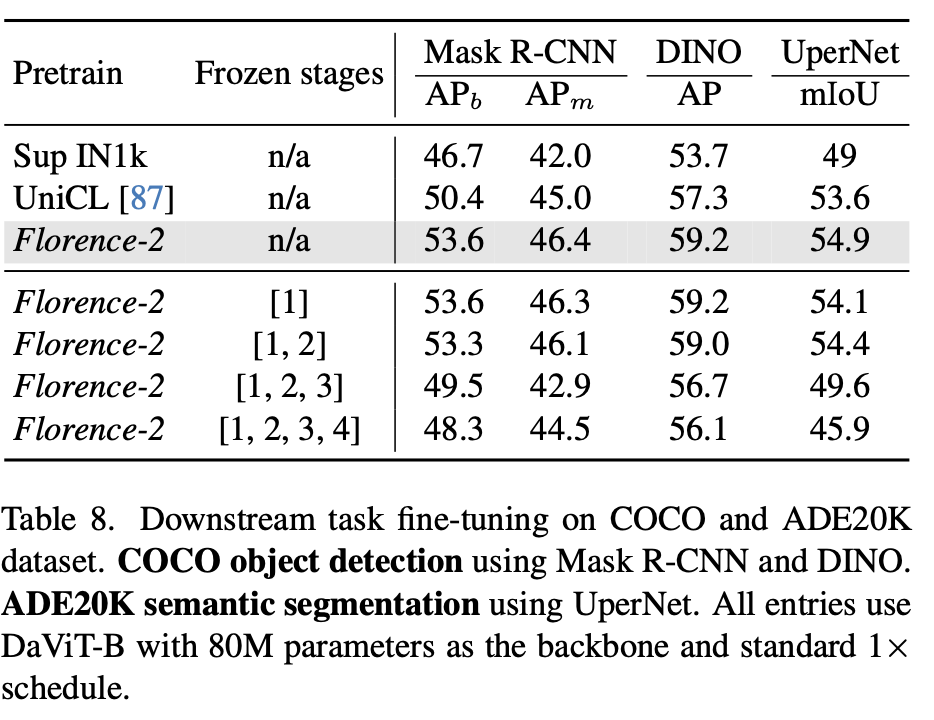
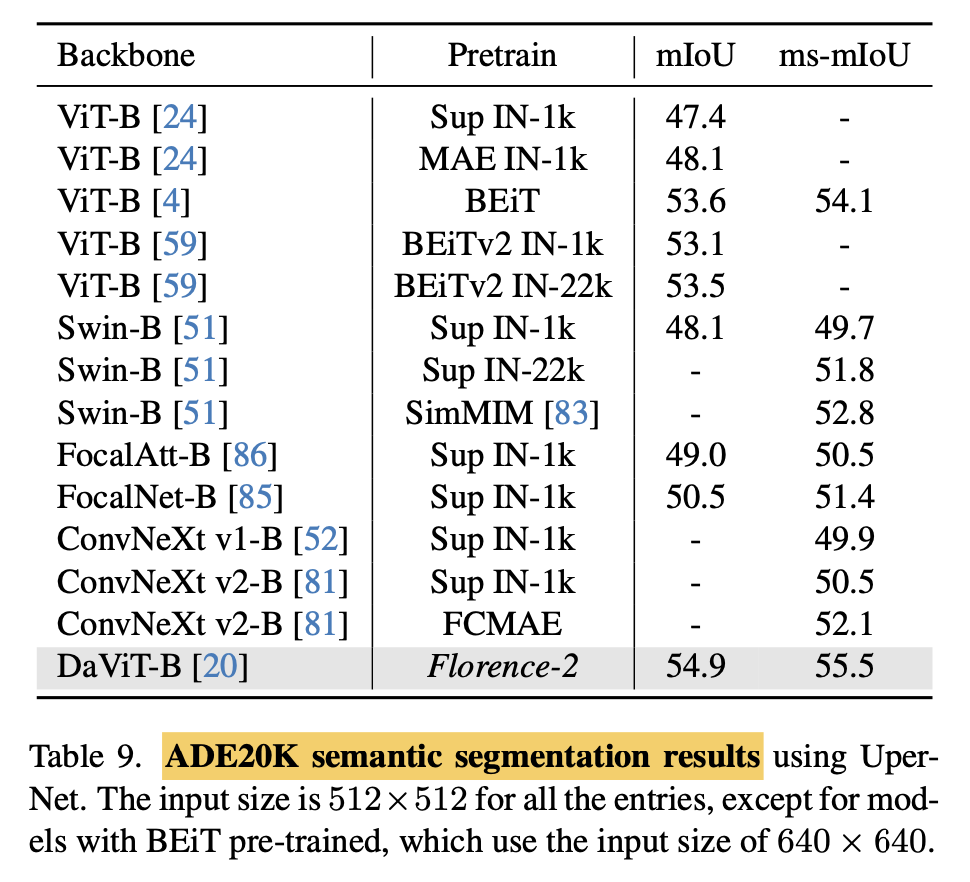
-
-
Ablation studies
-
image-level vs. image + region level vs. image + region + pixel level
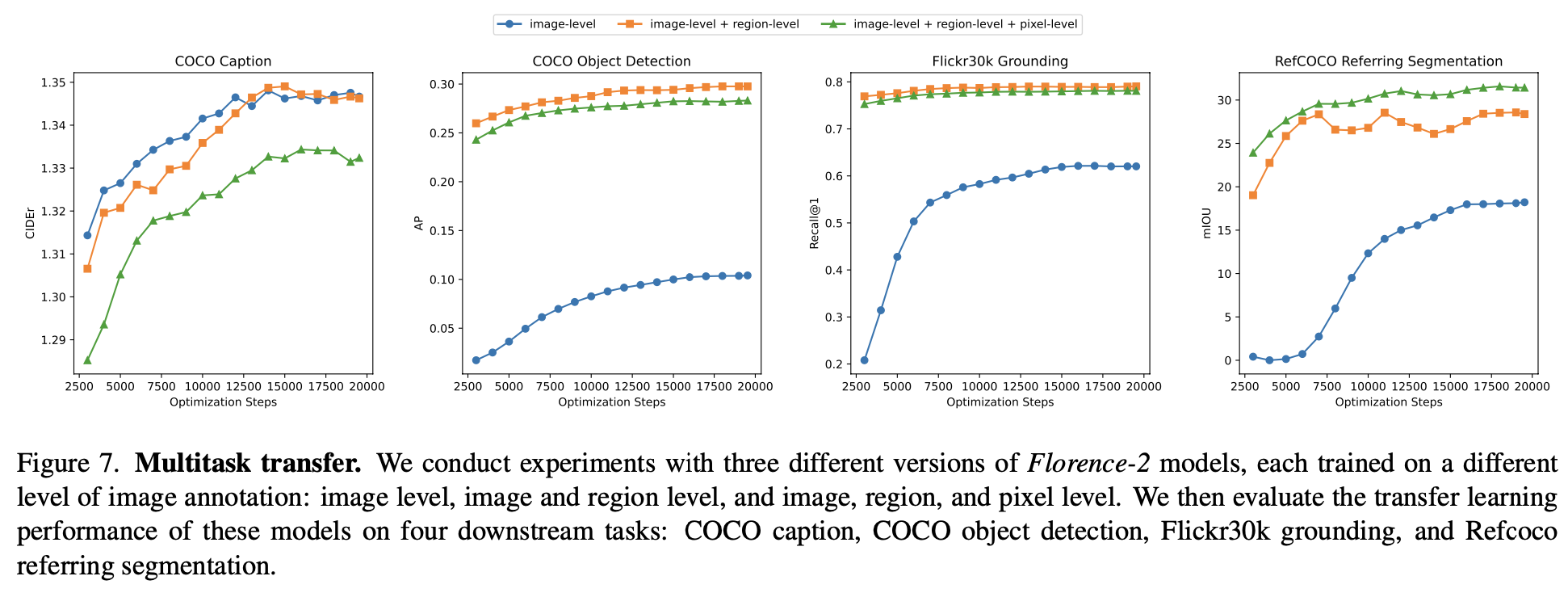
-
Model scaling
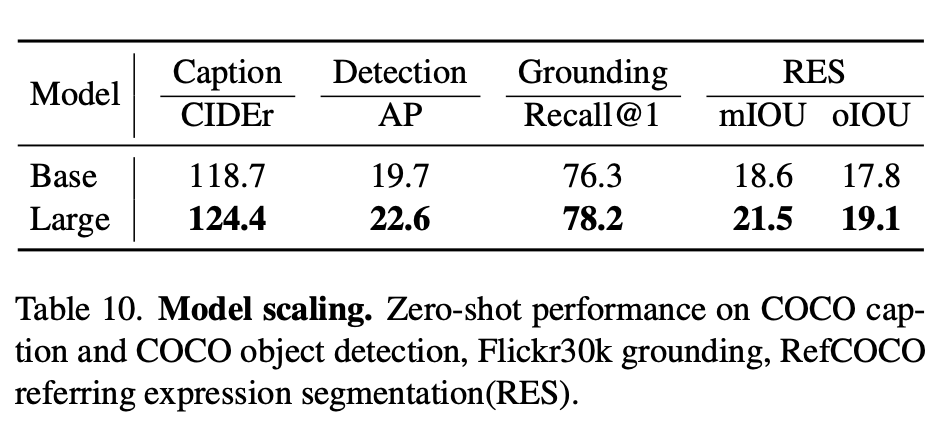
-
Data scaling

-
Freezing
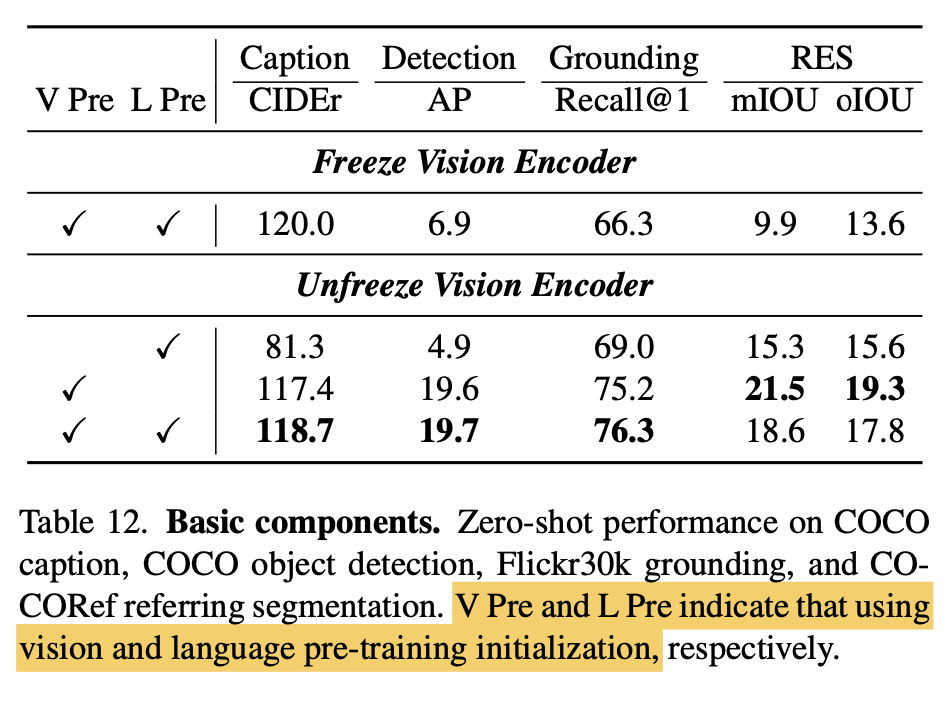
-